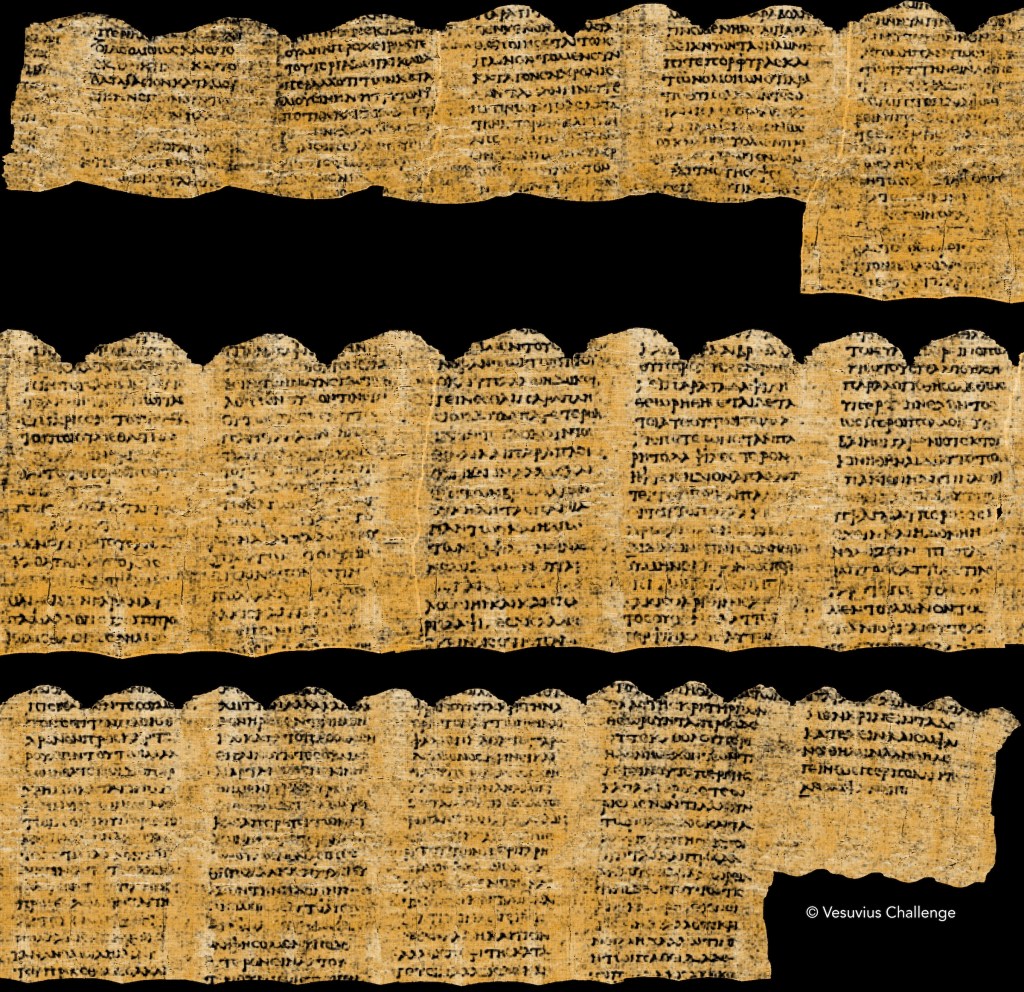A “superteam” of three university students from across the globe have successfully revealed passages from a 2,000-year-old scroll that was badly burned after the eruption of Mount Vesuvius, all without unfurling the delicate and damaged text.
Youssef Nader, Luke Farritor, and Julian Schilliger created a series of machine learning algorithms to digitally unfurl and read 15 panels of a Herculaneum papyrus, revealing ancient reflections on life, food, and music. The papyrus is a part of an ancient library of scrolls in Naples, Italy that was buried when the neighboring volcano Mount Vesuvius erupted in 79 AD. The eruption carbonized the works and made them impossible to open.
Videos by VICE
Their achievement has earned them the $700,000 grand prize in the Vesuvius Challenge—a contest conceived in March 2023 by US tech executive Nat Friedman, entrepreneur Daniel Gross, and computer scientist Brent Seales. The win was announced on Monday.
The team, led by Freie Universität Berlin PhD student Nader, used 3D scan data provided by the contest’s organizers and developed several machine learning algorithms that virtually unfurled and spliced different parts of the parchment together in a process called segmentation, then detected ink on the parchment to read it. 21-year-old computer science major Farritor and ETH Zürich robotics student Schilliger handled segmentation, while Nader developed the ink detection model.
Farritor and Schilliger were able to piece together large chunks of the papyri from several scrolls, validating previous writings and revealing totally new segments from other parts of the scroll, including the damaged and notoriously-tricky to read outermost wrap.
Meanwhile, the final ink detection model revealed 11 columns of text containing more than 2,000 characters of ancient writing—well above the four passages of 140 characters needed for the grand prize win.
Nader explained to Motherboard the secret of the model’s success, which lay in treating the 3D scans like a stack of 2D images, and then running the data through a string of three AI architectures. “This model, by treating it just as a sequence and looking at the shape of the sequences and how they vary, becomes very efficient and very powerful in learning the structure of ink on the scroll,” Nader said. Vesuvius Challenge judges called the model “unparalleled.”
All three winners are veterans of the competition. Last October, Farritor became the first person in history to read an entire word from inside the scroll, winning him the First Letters prize. Nader won second place for the same prize, reading the same word with even more clarity. Meanwhile, Schilliger had won three Segmentation Tooling prizes.
The scale of the challenge and drive to be the first to complete the task urged Nader to form the team. “I needed to find strong team-mates to push this through,” he said. “I was trying to portray my vision of how we should approach this and obviously we had a lot of discussions.”
It took less than a year since the challenge’s inception for them to read the passages, but was by no means a breezy process. “It was quite tiring but extremely rewarding,” said Nader. “It was like an adrenaline rush. Even if I only slept four hours I’d wake up really excited to see what my AI model was up to.”
Nader said that feeling of excitement only grew as they worked for longer on the project. He said he started to notice ink deposits and how certain letters were thicker in parts than others, showing him where the scribe had started writing. “I started to feel a connection with the ancient scribe. It was really fun to work on this.”
Now a separate panel of papyrologists has begun transcribing what Nader and his team uncovered. They think the scrolls were written by Epicurean philosopher Philodemus, who was residing at the library at the time. He writes about food, music and how to enjoy life’s pleasures akin to a “2000-year-old blog post about how to enjoy life.” According to a social media post by Friedman, the philosopher even “throws shade at unnamed ideological adversaries.”
The win of the grand prize doesn’t mean that the quest to uncover more about these timeworn scrolls is over. Roughly 95 percent of these particular scrolls remain to be read, and they are just four out of more than 800 surviving documents. The challenge will award $100,000 in 2024 to whoever can read 90 percent of each of their four scrolls.




